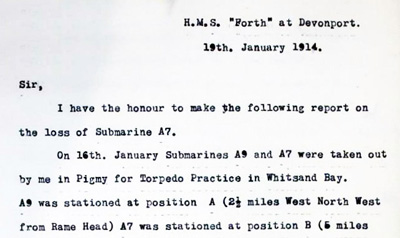Project 3: Research

Extract from the report on the loss of HM submarine A7 (NA)
One of the aims of the project was to research the story of the life and loss of HM submarine A7 then to try to understand why she was lost during a routine training exercise in 1914. Many sources of information were used, some were original, primary sources such as letters or technical design information while others were secondary sources such as books and newspapers.
The National Archives in London, provided some very interesting technical information in the form of the Ships Covers (ADM 138-246A Ships Covers 290). This collection of letters and notes includes detailed design information for the earliest Royal Navy submarine classes from Holland to D class. Documents about the loss of A7 are in the collection ADM 1-8373-91-01 which includes telegrams between Plymouth and the Admiralty, the official loss report, a report on the safety of the A class boats and a chart showing where the submarine was lost.
Engineering drawings for the later A class boats including A7 were searched for but not found. Internal general arrangement plans for A1 and the early boats A2-A5 were found in the National Maritime Museum and the Barrow Archive along with plans for the prototype diesel boat A13. A1 was a very different design, A2-A5 were similar but showed significant design differences and A13 was different again. No plans showing the external fittings on any of the variants have been found so far.
The story of the loss of A7 has been well documented in a number of newspapers such as The Times, the Western Evening Herald, the Western Morning News and the Illustrated London News. The Times is available online but the two local newspapers were only available at Plymouth Library and the relevant copy of the Illustrated London News was bought on eBay. The newspapers provided daily updates on the loss, the search for the submarine and the attempted salvage which gave us additional details missed out of the official Admiralty communications. The newspapers also gave background information about the crew of the submarine and their families which was not available through other sources.
 500.jpg)
Postcard commemorating the loss of HMS/M A7 (Lawrence collection)
The collection of photographs from the RN Submarine Museum in Portsmouth provided information about the external fittings on the hull and how the boats were rigged at sea. A private collection of postcards was made available to us by Julie Lawrence which contained many photographs of A7 and her sister boats that were not in the RN collection or available online.
The Devonport Naval Heritage Centre library has copies of the journal Engineering from the period when the submarines were built, and these journals provided useful technical information about the development of these and similar submarines. The library also contained copies of the Transactions of the Institution of Naval Architects which included Bacon's paper Notes on the Causes of Accidents to Submarine Boats, and their Salvage.
The published account of events in Parliament, Hansard, gave us background information about the development of early submarines and how the loss of A7 was discussed in government.
A number of people associated with the submarine were interviewed including relatives of the crew lost on the sumarine, divers who found the site or visited it soon after it was found and people involved in the designation of the site.
Many books and web sites were consulted and used for reference, see the bibliography for a complete list. In particular the autobiography of Captain Bacon, From 1900 Onward, told us much about how the A class boats were designed and in the autobiography of Frank Cable (Holland's test pilot) The Birth and Development of the American Submarine, we find out how the first vessels operated and about their long succession of teething problems.

